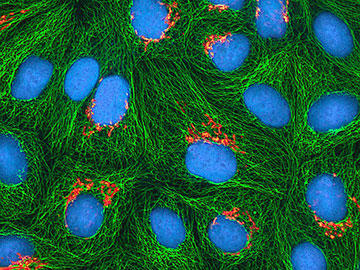Method for Identifying Combination Therapies to Combat Treatment Resistance Shows Promise
, by NCI Staff
The research community and biopharmaceutical industry have had marked success over the past 10 to 15 years in developing therapies that target genetic changes involved in cancer cell growth and survival. But these targeted therapies have an Achilles heel; in nearly all patients who initially experience tumor shrinkage, their tumors eventually start growing again.
The culprit in these cases? Acquired resistance—that is, the tumor cells develop additional mutations that render the targeted therapy ineffective, or they use alternative communication pathways to transmit the biochemical signals they need to resume growing and traveling throughout the body.
Researchers have learned a great deal about why and how treatment resistance occurs, but they have had limited success in developing new therapies or combinations that address the problem.
Now, researchers from the Massachusetts General Hospital (MGH) Cancer Center in Boston have reported on a method for studying treatment resistance that may identify combinations of targeted therapies that can help to combat resistance in some patients. The study, funded in part by NCI, was published November 13 in Science.
The approach relies on establishing cancer cell lines from patient tumor samples, something that has traditionally been very difficult to do. But, using a new technique that has been shown to improve the success rate, the researchers were able to establish cell lines from 40 percent of the patient biopsy samples they used. The success rate would likely have been higher had the quality of the samples been higher, they wrote.
The cell lines were derived from tumors of patients with lung cancer that had developed resistance to either an EGFR inhibitor or an ALK inhibitor. The research team tested a panel of 76 targeted agents—either alone or in combination with the agent to which the tumor had become resistant—on these cell lines.
In many cases, they identified drug combinations that could overcome treatment resistance—that is, the treatment-resistant tumor cells died when they were exposed to the original drug to which they had become resistant plus another specific targeted therapy.
The team from the MGH Cancer Center were able to replicate their success in some mouse models of resistant tumors that were established using the patient-derived cells. The researchers induced prolonged tumor shrinkage in mice that received both the drug to which the tumor cells had become resistant plus a specific targeted therapy that was identified as a “hit” when tested in the laboratory against the resistant cell lines.
The screening process needs to be further refined and tested, the researchers wrote. It is currently time consuming and not yet practical for directing patient treatment. But it holds promise, Jeffrey Engelman, M.D., Ph.D., a senior author of the study, said in a news release.
"This screen was so effective that we think it warrants a serious effort to develop the technology for personalized treatment decision making," he said.
